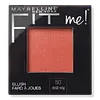What's inside
What's inside
 Key Ingredients
Key Ingredients

 Concerns
Concerns

 Ingredients Side-by-side
Ingredients Side-by-side

Silica
AbrasiveTriethylhexanoin
MaskingDimethicone
EmollientSynthetic Fluorphlogopite
Cetyl Ethylhexanoate
EmollientHydrogenated Polydecene
EmollientSynthetic Wax
AbrasiveIsononyl Isononanoate
EmollientMica
Cosmetic ColorantMicrocrystalline Wax
Emulsion StabilisingSorbitan Sesquiisostearate
EmulsifyingCaprylyl Glycol
EmollientTin Oxide
AbrasiveTocopheryl Acetate
AntioxidantCaesalpinia Sappan Bark Extract
Skin ConditioningCI 77891
Cosmetic ColorantCI 77491
Cosmetic ColorantBlue 1 Lake
Cosmetic ColorantSilica, Triethylhexanoin, Dimethicone, Synthetic Fluorphlogopite, Cetyl Ethylhexanoate, Hydrogenated Polydecene, Synthetic Wax, Isononyl Isononanoate, Mica, Microcrystalline Wax, Sorbitan Sesquiisostearate, Caprylyl Glycol, Tin Oxide, Tocopheryl Acetate, Caesalpinia Sappan Bark Extract, CI 77891, CI 77491, Blue 1 Lake
Talc
AbrasiveMagnesium Stearate
Cosmetic ColorantTriisostearin
Skin ConditioningPhenyl Trimethicone
Skin ConditioningSynthetic Fluorphlogopite
Caprylyl Glycol
EmollientAlumina
AbrasiveSilica
AbrasiveMagnesium Silicate
AbsorbentCalcium Sodium Borosilicate
Calcium Aluminum Borosilicate
Tin Oxide
AbrasiveMica
Cosmetic ColorantCI 77891
Cosmetic ColorantCI 77491
Cosmetic ColorantCI 77492
Cosmetic ColorantCI 77499
Cosmetic ColorantCI 77007
Cosmetic ColorantCI 75470
Cosmetic ColorantCI 15850
Cosmetic ColorantCI 45410
Cosmetic ColorantCI 15985
Cosmetic ColorantCI 77742
Cosmetic ColorantCI 73360
Cosmetic ColorantCI 19140
Cosmetic ColorantCI 77400
Cosmetic ColorantCI 42090
Cosmetic ColorantCI 77163
Cosmetic ColorantCI 77000
Cosmetic ColorantCI 77510
Cosmetic ColorantCI 16035
Cosmetic ColorantTalc, Magnesium Stearate, Triisostearin, Phenyl Trimethicone, Synthetic Fluorphlogopite, Caprylyl Glycol, Alumina, Silica, Magnesium Silicate, Calcium Sodium Borosilicate, Calcium Aluminum Borosilicate, Tin Oxide, Mica, CI 77891, CI 77491, CI 77492, CI 77499, CI 77007, CI 75470, CI 15850, CI 45410, CI 15985, CI 77742, CI 73360, CI 19140, CI 77400, CI 42090, CI 77163, CI 77000, CI 77510, CI 16035
Ingredients Explained
These ingredients are found in both products.
Ingredients higher up in an ingredient list are typically present in a larger amount.
Caprylyl Glycol is a humectant and emollient, meaning it attracts and preserves moisture.
It is a common ingredient in many products, especially those designed to hydrate skin. The primary benefits are retaining moisture, skin softening, and promoting a healthy skin barrier.
Though Caprylyl Glycol is an alcohol derived from fatty acids, it is not the kind that can dry out skin.
This ingredient is also used as a preservative to extend the life of products. It has slight antimicrobial properties.
Learn more about Caprylyl GlycolCi 77491 is also hydrated iron III oxide. It's sole purpose is to give a red/pink hue to products.
Iron III oxides are classified as inorganic chemicals for coloring.
Synthetically created Ci 77491 is considered safer than those naturally found. This is because the synthetically created version may contain less impurities. Iron oxides are generally non-toxic and non-allergenic.
Learn more about CI 77491Ci 77891 is a white pigment from Titanium dioxide. It is naturally found in minerals such as rutile and ilmenite.
It's main function is to add a white color to cosmetics. It can also be mixed with other colors to create different shades.
Ci 77891 is commonly found in sunscreens due to its ability to block UV rays.
Learn more about CI 77891Mica is a naturally occurring mineral used to add shimmer and color in cosmetics. It can also help improve the texture of a product or give it an opaque, white/silver color.
Serecite is the name for very fine but ragged grains of mica.
This ingredient is often coated with metal oxides like titanium dioxide. Trace amounts of heavy metals may be found in mica, but these metals are not harmful in our personal products.
Mica has been used since prehistoric times throughout the world. Ancient Egyptian, Indian, Greek, Roman, Aztec, and Chinese civilizations have used mica.
Learn more about MicaSilica, also known as silicon dioxide, is a naturally occurring mineral. It is used as a fine, spherical, and porous powder in cosmetics.
Though it has exfoliant properties, the function of silica varies depending on the product.
The unique structure of silica enhances the spreadability and adds smoothness, making it a great texture enhancer.
It is also used as an active carrier, emulsifier, and mattifier due to its ability to absorb excess oil.
In some products, tiny microneedles called spicules are made from silica or hydrolyzed sponge. When you rub them in, they lightly polish away dead skin layers and enhance the penetration of active ingredients.
Learn more about SilicaSynthetic Fluorphlogopite is the synthethic version of mica. It consists of fluorine, aluminum and silicate.
Synthetic Fluorphlogopite is used to add volume to products.
It is considered non-irritating on the skin.
Learn more about Synthetic FluorphlogopiteTin Oxide is an inorganic oxide used to add opacity and volume to a product. In nature, it is already found in mineral form. The main ore of tin is an opaque and shiny mineral called casseterite.
Tin Oxide helps remove translucency in a product, or make it more opaque. Besides adding opacity, tin oxide is used for bulking to add volume.